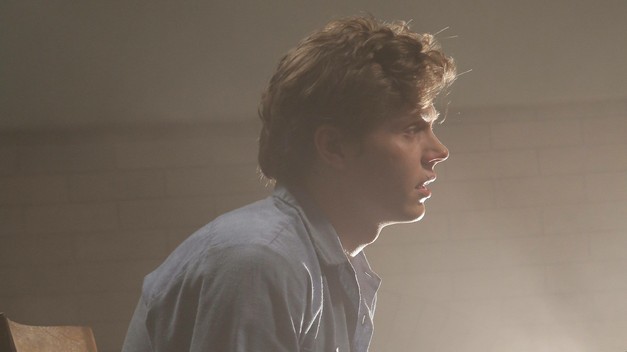
Lana’s attempts to “cure” herself of her homosexuality was by far the most disturbing part of last night’s American Horror Story.
With a title like “I Am Anne Frank, Part 1,” it should come as no surprise that episode four of American Horror Story: Asylum is all about a crisis of identity.
We are in a mental asylum after all, where perhaps the oldest cliché in entertainment is that of the madman who believes he’s Jesus Christ, Napoleon Bonaparte or whomever. The story has been done on every program from M*A*S*H to The Simpsons, but never with quite so much thematic depth as Asylum.
AHS can’t have thematic depth, you say? Ah, well that’s where you’re wrong — sure it’s gory, over-sexualized and perpetually on the cusp of absurdity, but “I Am Anne Frank, Part 1” once again finds Asylum at its best: Well constructed, just a little bit thoughtful and quite disturbing.
After last week’s torrent of mysterious phantasms, this week focuses entirely on psychological horror, with Dr. Arthur Arden’s apparent Nazi past, Kit Walker and Grace’s brush with sexual sterilization and, most disturbing of all, Lana Winters’s attempts to rid herself of her homosexuality.
The Anne Frank portion of the episode is easily the most boring aspect of the show — and the shortest of the interconnected vignettes — but it helps to tie all the stories together under the thematic moorings of Anne’s much-contested identity.
After being tossed into Briarcliff Manor for starting a bar fight over some anti-Semitic jokes, Anne comes face to face with Arthur, who she recognizes from Auschwitz concentration camp. This leads to the focal point around which all the stories pivot.
Anne is taken to see Sister Jude, where she explains her story and how she escaped from Europe. Her conversation is paralleled with a conversation between Kit and Dr. Oliver Thredson, the latter of whom is trying to get Kit to admit that he is a killer, but only kills because he’s crazy.
A third scene, between Lana and Oliver, also enters the fray. In this case, the good doctor is trying to help Lana cure herself of her attraction to women so he can help her escape.
Each situation focuses on aspect of identity: Anne is trying to convince Sister Jude that she really is Anne Frank, Oliver is trying to make Kit believe he is someone he is not and Lana is actively trying to become someone she is not.
Each story then spirals out into their experiences.
Again, Anne’s is the least interesting, although we do get glimpses of a young Arthur plucking identical twins off the trains at Auschwitz and performing horrible experiments on them, making a potent analogue to real-life Nazi war criminal Josef Mengele.
Between the suspicions about his past and the complaints of the prostitute he tried to murder on episode two, Arthur has been put under the microscope of the law and Sister Jude — he seems to be a Nazi and he might even be the real Bloody Face. As we find out, Monsignor Timothy Howard is in on Arthur’s evil concoctions, although to what end we are unsure.
Trying to clean up the mess, Arthur attempts to kill Anne, who pulls a gun on him and shoots the doctor through the leg. Just as she’s about to get her revenge, Anne discovers Shelley the Nymphomaniac, legless and covered in horrible scars.
It’s totally disgusting, but still comes off as a bit of a weak cliffhanger. It does, however, seem to say that Anne isn’t lying about who she is.
Elsewhere, Kit is struggling with the idea that he might actually be more than just a man wrongly accused. Aside from the fact that Evan Peters played a nice guy who turned out to be the central murderer in the first series of AHS (and therefore isn’t likely to fill that role again), the audience already has a pretty good idea that Kit is probably telling the truth about the aliens.
Things become mighty unpleasant for Kit when he starts doubting his own sanity because of Oliver’s approximation of when, how and why Kit killed all the women, including his own wife.
Kit bounces his ideas off of Grace, who responds by recounting her own story about how she ended up in Briarcliff Manor as a victim of the machinations of her murderous family members. According to her, a plan was made to murder Grace’s whole family and then frame her.
At first, this story makes Kit stand up for his own story about the alien abduction and, of course, lights the fire between him and Grace. Discovered on the bakery table, Kit and Grace are chosen by Sister Jude to be sterilized for their indiscretion.
At this point, the possessed Sister Mary Eunice shows Kit Grace’s file, which has solid evidence that she killed her whole family. The information sends Kit into tailspin, made worse when Grace adds another layer to the story, saying that she had to kill her mother and father because her father was molesting her and her mother didn’t stop it.
Now Kit doesn’t know what to believe. He breaks down in front of Sister Jude, unsure if his abduction was real or if God saw him commit the murderers despite his lack of memory.
It’s not perfectly done, but the layers of identity confusion are fantastic between Kit, Grace and Sister Jude. Sister Jude is going through her own crisis, what with being seen intoxicated on last week’s episode and being unable to admit her own murderous transgression from the past. Every scene between Kit and Sister Jude is perfectly acted, each character trying to read the other despite an inability to be honest with themselves.
Best of all is Lana’s riveting and shocking story arc, wherein she decides to go along with Oliver’s psychological treatments to remove the homosexuality from her system. Lana’s decision to change is brought on by her fear of being trapped in Briarcliff forever, along with Oliver’s goading.
The great part of this is how morally gray it make Oliver seem. In both Kit and Lana’s cases, his intention is to help them — he doesn’t believe Kit should die for being mad and he doesn’t believe Lana belongs in such horrible place as Briarcliff.
That being said, his methods seem horrible, between trying to convince Kit of something that isn’t true and trying to erase Lana’s desires in any way possible (still treating homosexuality as a disease of the mind).
One of the best scenes in the episode occurs when Lana has a hallucinatory moment in the common room, imagining herself on a podium receiving an award for the great story she will write about Briarcliff. It’s an incredibly well-staged scene that adds a healthy dose of surrealism to Lana’s experience. In the end, she sees her framed award being used as the plate on which her daily dose of drugs is being served.
The most disturbing portion of the episode comes when Oliver attempts aversion/conversion therapy with Lana. While looking at pornographic images of women, Lana is given drugs to make her vomit. Afterwards, a young man is brought in and Lana is made to touch herself while “regarding” the boy’s physique and eventually touching his body.
The scene is far more disturbing than any jump scare or monster we’ve seen in previous weeks — if I had it my way, I would hope that Asylum continues pumping out these psychological horror stories, as they are much more effective.
Almost unbelievably, this scene also marks the return of Ryan Murphy and Brad Falchuk’s most talked-about moment from the first series, when Dylan McDermott’s Ben Harmon was seen crying while masturbating. Here, we see Lana cry-masturbating, although unlike the silliness of the moment in the first season, Asylum’s version is downright disturbing.
It’s great to see the show reworking old tropes — and improving them — especially when they are tropes as ridiculous as that.
In the end, Lana can’t be cured. (Although, I have to point out that the aversion/conversion therapy was more than a bit ridiculous in execution.) Despite this, Oliver shows his good side and promises to help Lana escape by the end of the week, when his time at Briarcliff Manor comes to an end.
All in all, “I Am Anne Frank, Part 1” is certainly not the wildest episode of Asylum, but it may just be its most emotionally haunting. The fact that the show can comfortably switch between the surreal madness of “Nor’Easter” and the subversive psychological horror of episode four just goes to show the program’s impressive reach.
Sure, the switch-up in style can seem a bit schizophrenic, but that’s what Asylum is all about.
diversions@gmail.com



